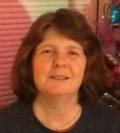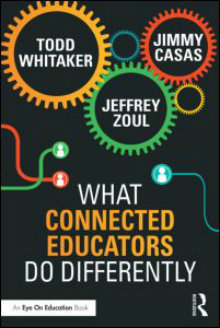Why and How to Connect with Educators
What Connected Educators Do Differently
By Todd Whitaker, Jeffrey Zoul, and Jimmy Casas
(Routledge/Eye on Education, 2015 – Learn more)

I have come to expect that I will be pushed outside my comfort zone when I read a work that Todd Whitaker is a part of. What Connected Educators Do Differently is no exception.
I am definitely a digital immigrant as I graduated college in the days when Selectric typewriters and TI-30 calculators were the hottest new products. I have done my best to immigrate: I have been using technology regularly in my classroom for some time, and since August I have been teaching at a one-to-one iPad school. But I have shied away from social media.

On the other hand, my fear of connecting online with others in an “unsecured” fashion (Twitter, Facebook, etc.), has been fueled by cases of teachers (and others) getting themselves into trouble on social media. Enter Whitaker, Zoul, and Casas.
A key to professional growth
One message the authors come back to several times centers around the idea that the work we do is so important that we must use not only our best thinking, but the best that we can borrow from others.
They emphasize that connected educators are committed to be lifelong learners and provide an abbreviated definition of connected educators as ones “who are actively and constantly seeking new opportunities and resources to grow as professionals.”
I definitely consider myself to fit that definition, so I need to take another step outside my comfort zone. The authors acknowledge that this reluctance to become connected is common among educators for a variety of reasons, and encourage us to move beyond our fears to reap the benefits of being connected.
Their first key piece of advice in the book is: Invest in a personal and professional learning network (P2LN). The authors are realistic that educators, including themselves, are extremely busy and being connected does take time. They suggest methods to become connected and yet still have a balanced life, and include a chapter (key connector 8) on “Know when to unplug.”
Furthermore, they emphasize throughout the book that while many of their connections began online (primarily through Twitter), they have forged some great personal relationships as a result. They and other connected educators value the opportunities to meet face-to-face and connect in person (often through conferences) and have developed many long-term friendships as a result.
Plentiful resources for each chapter
Throughout each of the first eight chapters or “key connectors,” the authors include references to some of the best resources on the topic under discussion. This gives us novices a place to start and not be quite so overwhelmed by all the possibilities.
Each chapter also ends with three short sections to help readers tie together the ideas and take the next steps to being connected. These include “Follow 5” (5 educators to follow who model the ideas in the chapter and the key advice) and “Find 5” (5 resources/tools to further develop in the areas discussed in the chapter). These are not redundant of the resources provided within the chapter, but additional sources that help readers drill further down.
Finally, each chapter ends with the “Take 5,” which provides five steps that can be taken to implement the ideas and grow as a connected educator.
Welcoming the world of ideas
Whether we are immigrants or natives, we live in a digital world where we can no longer afford to be isolated in our rooms. We have a compelling need to connect with other educators, not only in our buildings but across the world. Whitaker, Zoul, and Casas encourage us and help us find our way to becoming 21st century professional learners.
Since reading this book, I have set up a Twitter account, although I am still figuring out how it works, and I have participated in an online chat. Jeff Zoul was a part of the chat and extended an offer to help me if I need anything. I will be taking him up on his offer!
As the authors suggest, start small, take your time and stay the course, and you will soon be a connected educator reaping the wonderful benefits of a P2LN. So if you want to push your growth, you need to make professional use of social media. This book will be a great asset.
Dr. Laura Von Staden is a Special Education Middle School Teacher in Tampa, Florida. She serves on numerous committees both at her school and within her district and works closely with the local university where she is a Professional Practice Partner and a master mentor. Dr. Von Staden also facilitates both online and face-to-face Professional Development for her school district.




































